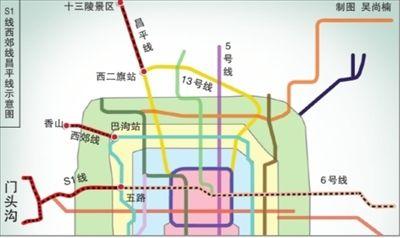Beijing's first maglev line resumes construction
CRI, April 21, 2015
China's first medium-to-low speed magnetic levitation, or maglev train, is now being built using domestically-produced technology.
A metro map of Beijing subway lines and Line S1, China's first medium-to-low speed maglev, short for magnetic levitation, train. [Photo: bjnews.com.cn]
Line S1, which will become Beijing's first maglev train, is set to connect the city's western district of Mentougou to the Pingguoyuan subway station, located in the city's Shijingshan district. Line S1 will cover more than 10km and connect eight subway stations: Shimenying, Xiaoyuan, Beijing Municipal Bureau of Mine, Shang'ancun, Shilonglu, Sidaoqiao, Jin'anqiao, and Pingguoyuan.
The maglev train can run at a speed of 80 km per hour; given the low-medium speed of the vehicle, the train tops out at a speed of a 105 km per hour.
The new line will be built by China CNR, which will make it the first maglev train manufactured in China. The train will be operated by Beijing Suburban Railway, or BCR, and can serves about 1032 passengers at one time.
The Beijing maglev train is being billed as a safe, economical alternative to the city's current light-rail cars. The train emits a noise of about 65 decibels and has maintenance costs lower than its older counterparts. However, the maglev train needs 15 percent more power to run than subway or light rail trains.
The construction of Line S1 was first initiated in 2011, but had to be postponed since the people living near the proposed line raised issues about exposure to radiation emitted by the train. More than 300 residents living in and around Mentougou and in the Bisenli community signed a petition opposing the maglev line when the draft plan was released in 2011. Even though the tests have indicated that the radiation levels are safe, people are still concerned, which led to further environment assessment the following years. The stagnated project was resumed in October, 2014.
The line is part of Beijing's attempts to tackle environmental problems caused by heavy traffic, coal burning and over-urbanization. The maglev train literally produces zero emissions, compared with conventional trains that run on diesel or coal.
Line S1 is expected to commence operation towards the end of 2016.





